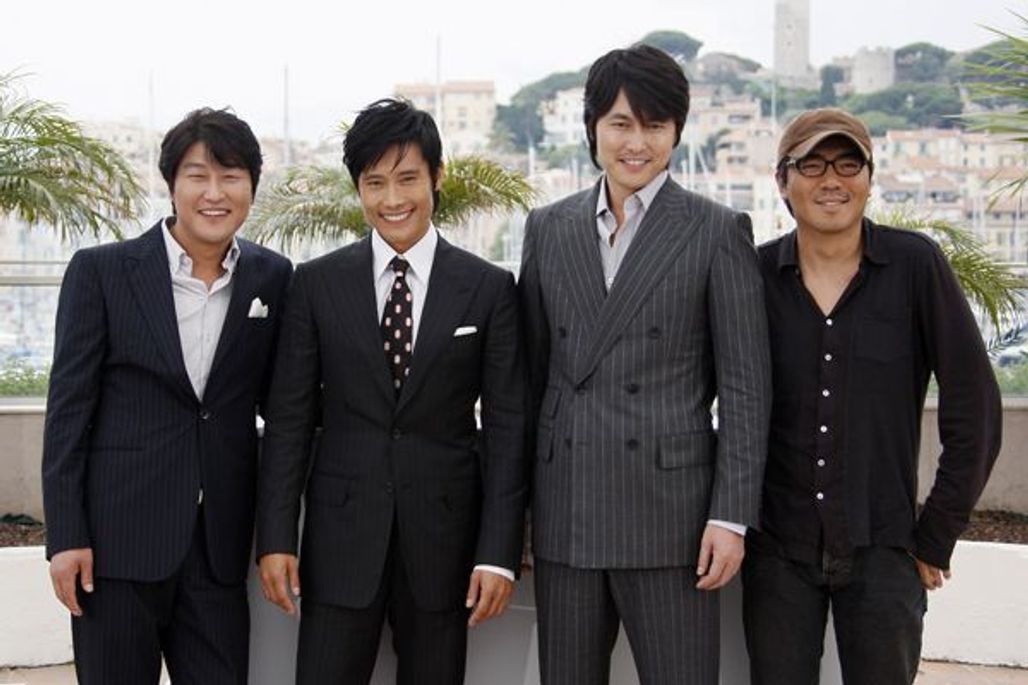
Press Conference: “The Good, the Bad, the Weird”

The full crew of The Good, the Bad, the Weird gathered to meet the press today. Present were director Jee-woon Kim and actors Woo-sung Jung, Byung-hun Lee, and Kang-ho Song. Here are the highlights:
Jee-woon Kim, on the westerns that have influenced him:
“I like films like High Noon, Shane, My Darling Clementine, or Gunfight at the OK Corral, and also Rio Bravo, the Howard Hawks film, but I think that I’m more influenced by films which show great strengths, and I’m thinking mainly of the Italian westerns, the films by Sergio Leone. In American westerns, they foreground American tradition and American values, whereas in Italian westerns, spaghetti westerns, I find much greater purely cinematographic pleasure. I find that there is much more expressivity in the characters. Naturally, I also enjoy many American westerns, particularly the more recent ones… There was a time when westerns began to look back into the past, with films like The Wild Bunch by Sam Peckinpah or The Unforgiven by Clint Eastwood. But I think, in fact, it’s above all Sergio Leone’s westerns that I find the coolest.”
Regarding their respective characters:
Byung-hun Lee:
“I think that basically, all these characters possess all three characteristics: the weird, the bad, and good; they’re all three at the same time. The worst of the three is probably the one who’s sitting next to me, and that’s the director!” (laughter)
Woo-sung Jung:
“Me, too. I am supposed to play the good character in the film, but I don’t think of my personality as purely good. The character himself is somebody who possesses a lot of sang-froid. But I don’t think you can be too manichean about this: it’s not all in black and white, so they don’t just split into three sharply divided characteristics. I think what’s important is the period and the environment in which these characters have to survive… So it’s the environment that makes them what they are.”
Jee-woon Kim, on conditions on the shoot:
In fact, shooting took about a hundred days in China. It was very difficult. A lot of things happened during the shooting period, particularly due to the weather. It was about 40°C in the morning, so we had to put up with the heat. All the actors were wearing heavy clothes, so they suffered from the heat… We also had to put up with dust storms, sand storms… Everything was extremely difficult. Then, as well as that, there was a problem of cultural differences, because a lot of the crew came from China…. There were major differences in the working methods… But when you look at the many films that have been made as joint efforts between Korea and China, this was, in fact, one that took place in a very friendly atmosphere. It was very successful from that point of view. Everyone felt involved.”
Woo-sung Jung, on masculine role models in westerns:
“I, too am very fond of westerns, particularly Clint Eastwood’s films, and the spaghetti westerns in which he appears. I’m also a great fan of the Trinity series, and Django, too. I’ve always been fond of the solitary cowboy character, with his gun. It’s obviously a very strongly virile and masculine side to these characters, and I think that every man, somewhere or other, dreams of being able to recreate this sort of character. So it’s quite amusing to try to get inside the skin of these typically western characters. I shall be very interested to see what Western audiences will make of this film.”


